Marketing for interior designers can be simple but complicated.
Do you know why?
It’s simple because you’ve got gorgeous content baked in.
It’s complicated because everyone’s fighting for eyeballs on Instagram and Pinterest—and let’s not even start on the algorithm drama.
Not to mention, 7 in 10 consumers read online reviews while researching businesses.
That means potential clients are Googling, scrolling, and stalking before they ever reach out.
Some of them could be searching for an interior designer who has a knack for mixing textures, and a sixth sense for layout flow.
So, how do you become the business they see when they’re on the hunt for an interior designer?
The answer is simple!
You post consistently with a social media management tool and apply doable strategies tailored to interior designers.
Here’s how you can make your designs stand out on social media and get your calendar filled with appointments!
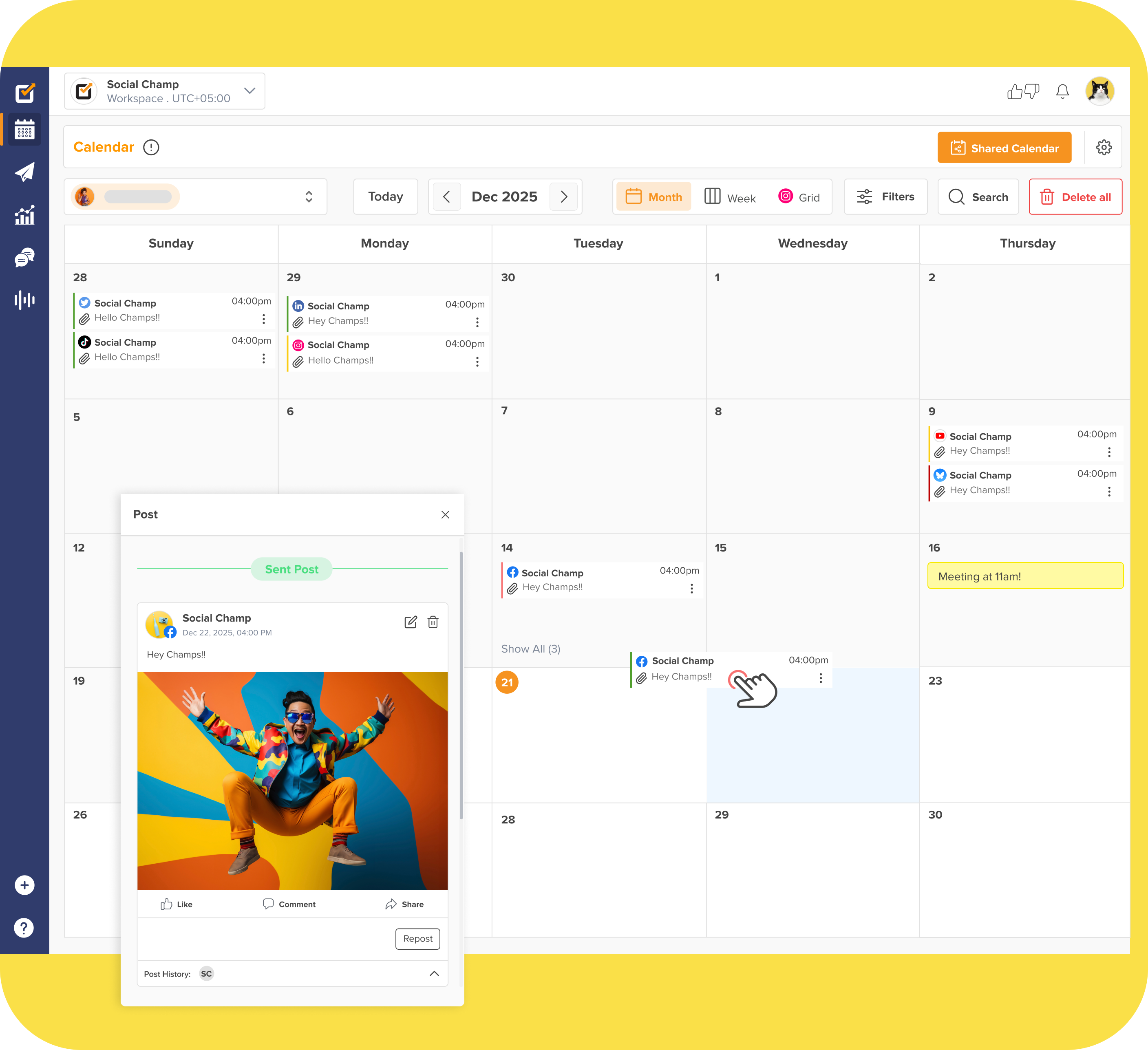
Your Next Big Project Can Find You Online.
Social Champ’s smart tools help you curate a captivating online presence that turns followers into clients. Plan, create, automate, and schedule from one dashboard.
Short Summary
- Standing out means creating a strong, consistent brand that reflects your style, voice, and client experience.
- Social media is a must—Instagram, Pinterest, and even TikTok—when used strategically, can showcase your portfolio and personality.
- Content marketing builds trust; share helpful tips, project stories, and answer common client questions to position yourself as an expert.
- SEO is critical—optimize for local searches, use real-world keywords, and ensure your site is fast and mobile-friendly.
- Tools like Social Champ help interior designers batch, schedule, and tailor content across platforms without the stress.
- With the right mix of storytelling, visuals, SEO, and smart automation, designers can attract dream clients without burning out.
Understanding the Unique Landscape of Marketing for Interior Designers
Marketing for interior designers is about selling transformation.
You’re not just offering a sofa arrangement; you’re selling peace of mind, elevated living, and that subtle wow-factor your clients didn’t even know they craved.
-
It’s Not Just Business, It’s Personal
Interior design is a high-trust service. Clients are literally inviting you into their personal spaces.
That means your marketing has to go beyond aesthetics—it needs to feel personal, human, and confidence-building.
People aren’t just looking for good taste—they’re looking for someone they can trust with their home (or office, or Airbnb investment).
Design is emotional. So your messaging should connect emotionally, too. Think testimonials, storytelling, and behind-the-scenes peeks.
-
The Visual Advantage (and Pressure)
Yes, you’ve got a leg up: design is inherently visual, and visual content rules online. But that also means the bar is sky-high.
Social feeds are saturated with curated interiors—your brand needs a recognizable edge.
It’s not enough to post a pretty photo. People want to know the story: Why that wallpaper? What problem did you solve in that layout?
-
Local vs. Digital: Navigating Both Worlds
Most designers still rely heavily on word-of-mouth and local referrals. But clients are doing digital homework—often long before they call.
Local SEO matters. If you’re not showing up on Google Maps or local directories, you’re missing warm leads.
A killer Instagram can attract attention, but a professional website seals the deal.
Featured Article: Unlock the Potential of Social Media Marketing for Local Businesses
Building a Strong Brand Identity to Stand Out in the Interior Design Market
Your brand is more than just a logo or color scheme—it’s the feeling you create, the story you tell, and the promise you make to your clients.
When done right, your brand becomes an experience that sticks with people long after they’ve seen your designs.
-
Define Your Design
To build a recognizable brand, you need to start by defining your unique design identity.
Your brand should communicate your style before you even speak.
Are you known for sleek, minimalist spaces that are calm and uncluttered?
Or do you thrive in creating bold, vibrant designs with a touch of eclecticism?
Whatever it is, your aesthetic should be reflected across every aspect of your business, from your website to your social media presence.
Your style should be unmistakable, so people instantly know when they’re looking at your work.
Beyond just the visual, your brand’s voice matters too.
How you communicate—whether through your website, social media posts, or client emails—should reflect your personality and approach to design.
Here’s an example.
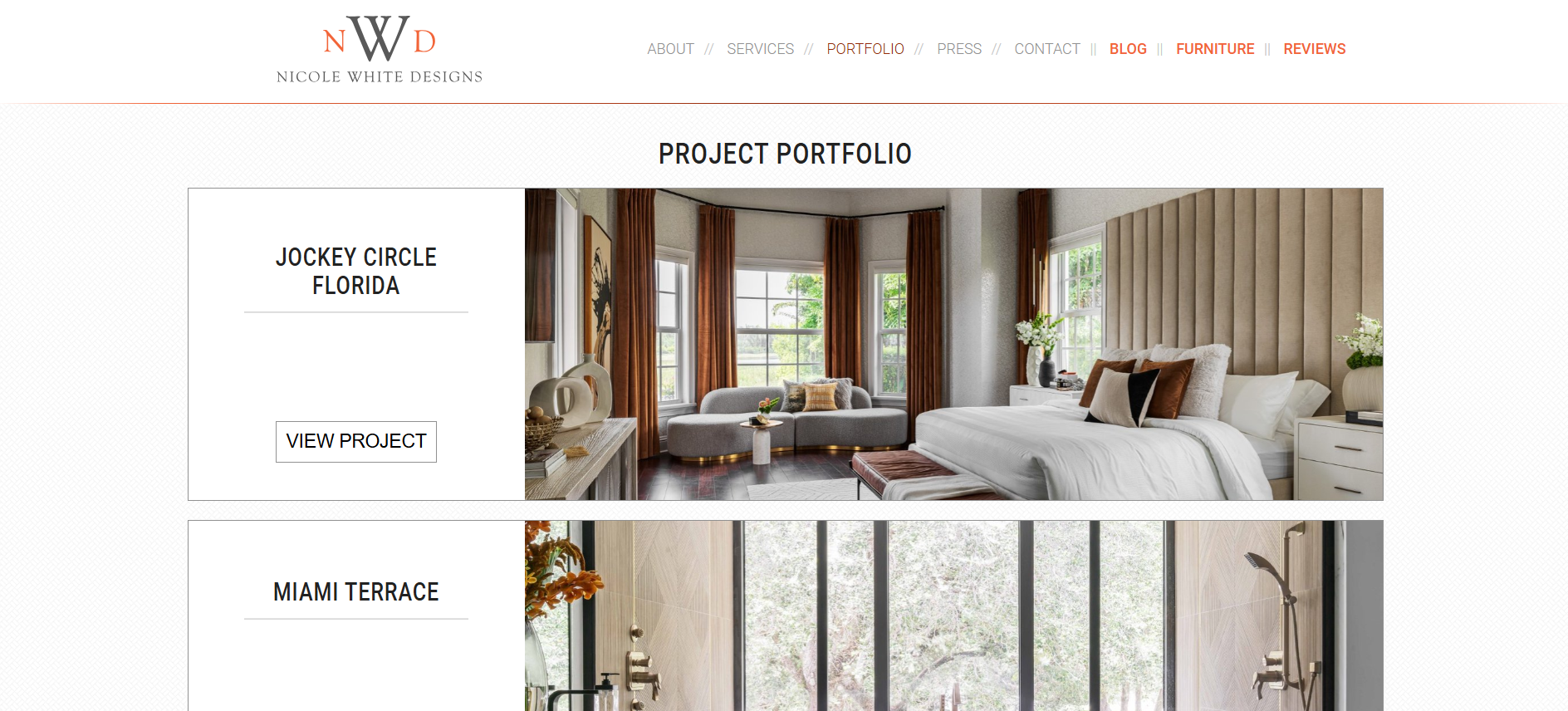
Nicole White Designs’ Webpage -
Avoid the “Pinterest Clone” Trap
It can be tempting to follow the latest design trends because they’re popular, but copying what everyone else is doing won’t help you stand out.
Sure, there’s a place for trends, but you need to find what sets you apart. Your designs and your brand should reflect what makes you different.
Don’t be afraid to experiment and take risks in your design style.
Maybe you’ve got a love for mixing unexpected textures or you specialize in reimagining spaces for unconventional uses.
Whatever it is, embrace your unique approach and let it define your brand.
-
Create a Signature Experience, Not Just a Look
Your brand isn’t just about how your work looks—it’s about the whole experience you provide. Think about how you can elevate every touchpoint of your client journey.
From the initial consultation to the final reveal, the process should feel like a seamless, enjoyable experience that is reflective of your brand.
If you pride yourself on providing a high-touch, concierge-style experience, make sure that shines through in every aspect of your communication.
-
Consistency Builds Trust
Consistency builds trust and ensures that your message is clear.
If a potential client has an experience with your brand that feels disjointed, it could create doubts about your professionalism.
Consistency goes beyond just aesthetics. It’s about ensuring that your messaging, client interactions, and design approach align with your brand’s core values.
Make sure you use the same color palette, typography, and imagery throughout your website, social channels, and marketing materials.
Investing in professional photography will make a huge difference in ensuring that the images of your work are presented in the best possible light.
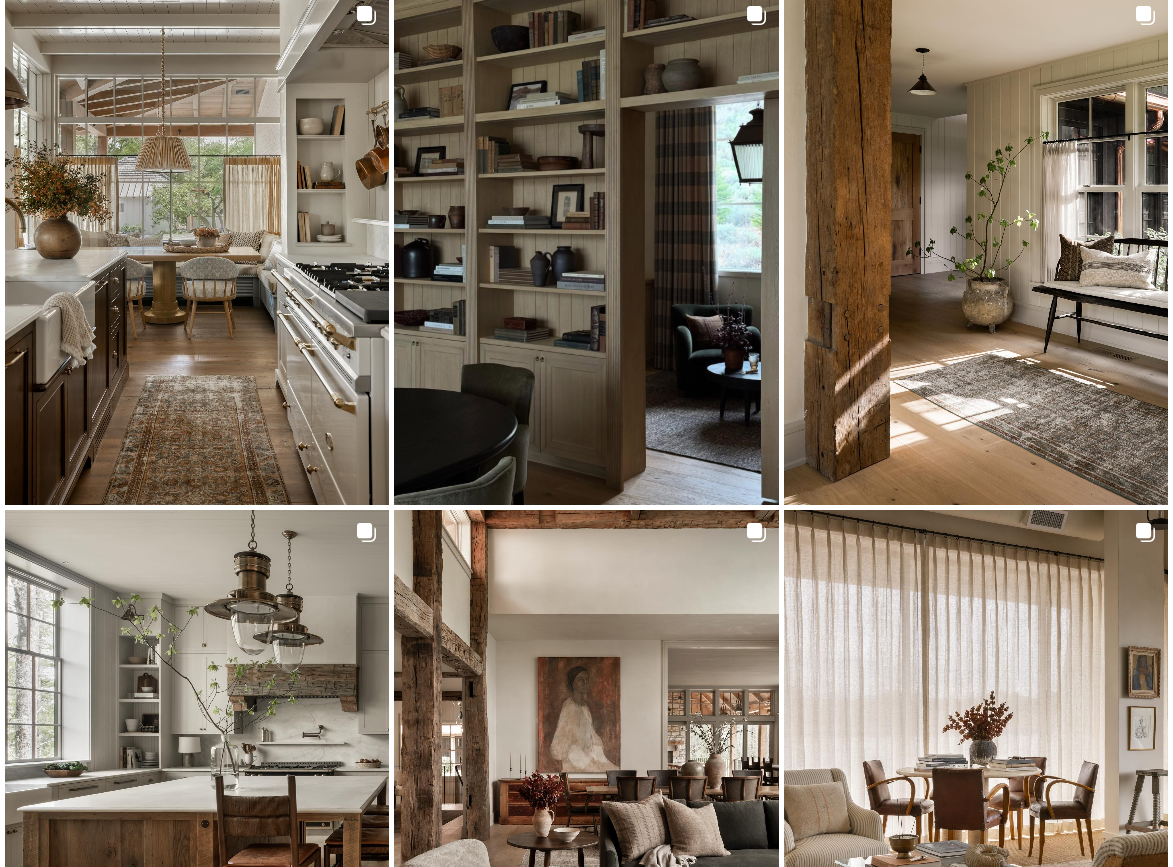
Instagram Grid of @amberinteriors
Leveraging Social Media Platforms to Showcase Your Interior Design Portfolio
Here’s how you can leverage social media platforms to showcase your work to a larger audience:
-
Choosing the Right Platforms for Your Brand
Not every platform deserves your energy. Interior design is a highly visual field, which makes Instagram and Pinterest essential—but how you use them matters.
Instagram is great for storytelling, showing your personality, and building relationships through stories, carousels, and reels.
Pinterest, on the other hand, is more like a search engine for visual ideas.
It’s where users go to plan future projects—making it perfect for evergreen content like mood boards, finished spaces, and how-to guides.
If your target clients are professionals, developers, or corporate decision-makers, LinkedIn might also be worth your time.
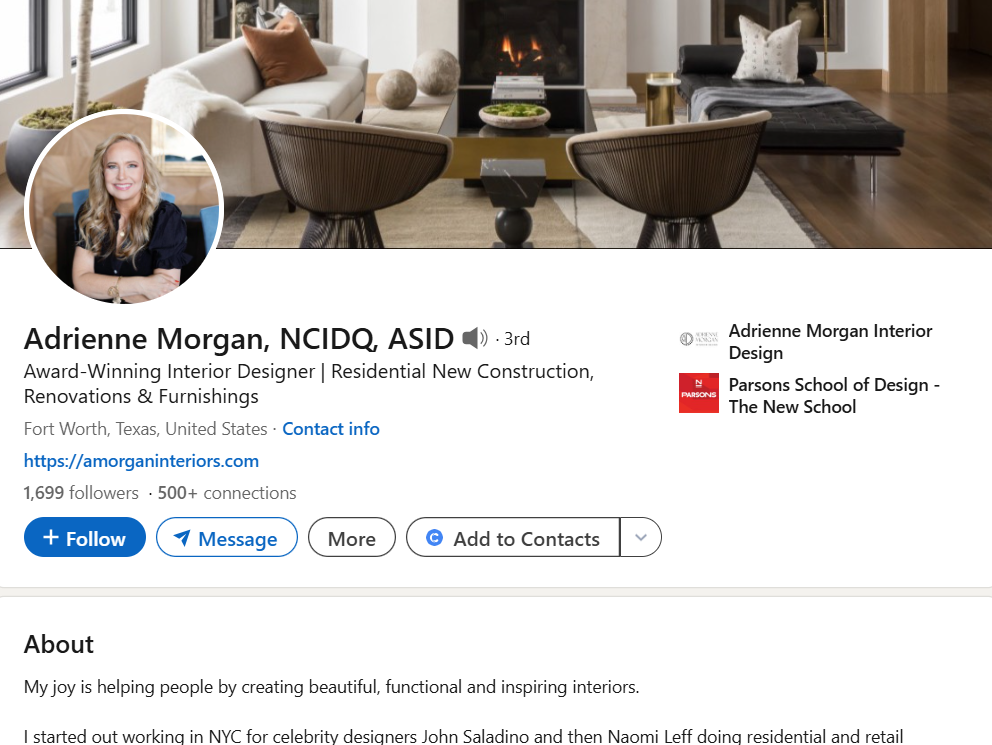
LinkedIn Profile of Adrienne Morgan And while TikTok may seem intimidating, short-form video content is dominating right now—and designers who show real transformations or design tips are finding loyal followings.
-
Tell Stories, Not Just Showrooms
A beautiful photo of a living room will catch someone’s eye—but a compelling caption about how you transformed that space will keep their attention.
Share the thought process behind your design choices. Talk about the challenges you faced, the materials you chose, or how you solved a client’s specific need.
When people understand the story behind the space, they become more emotionally invested in your work.
Don’t be afraid to show the mess, either. Before-and-after content performs exceptionally well.
Even short clips of demolition, sourcing, or a fabric-swatch humanize your process and build trust.
-
Make Your Work Discoverable
If you’re not using keywords, geotags, or hashtags strategically, you’re basically putting your best work in a drawer and locking it. Use location tags to attract local clients.
Optimize your captions with words people actually search for—like “modern kitchen remodel” or “Scandinavian apartment makeover.”
Pinterest titles and descriptions should also be loaded with keywords, not just clever lines.
More importantly, include clear calls to action. Whether it’s “DM me for project inquiries” or “Link in bio to view the full transformation,” your audience needs direction, so give it to them.
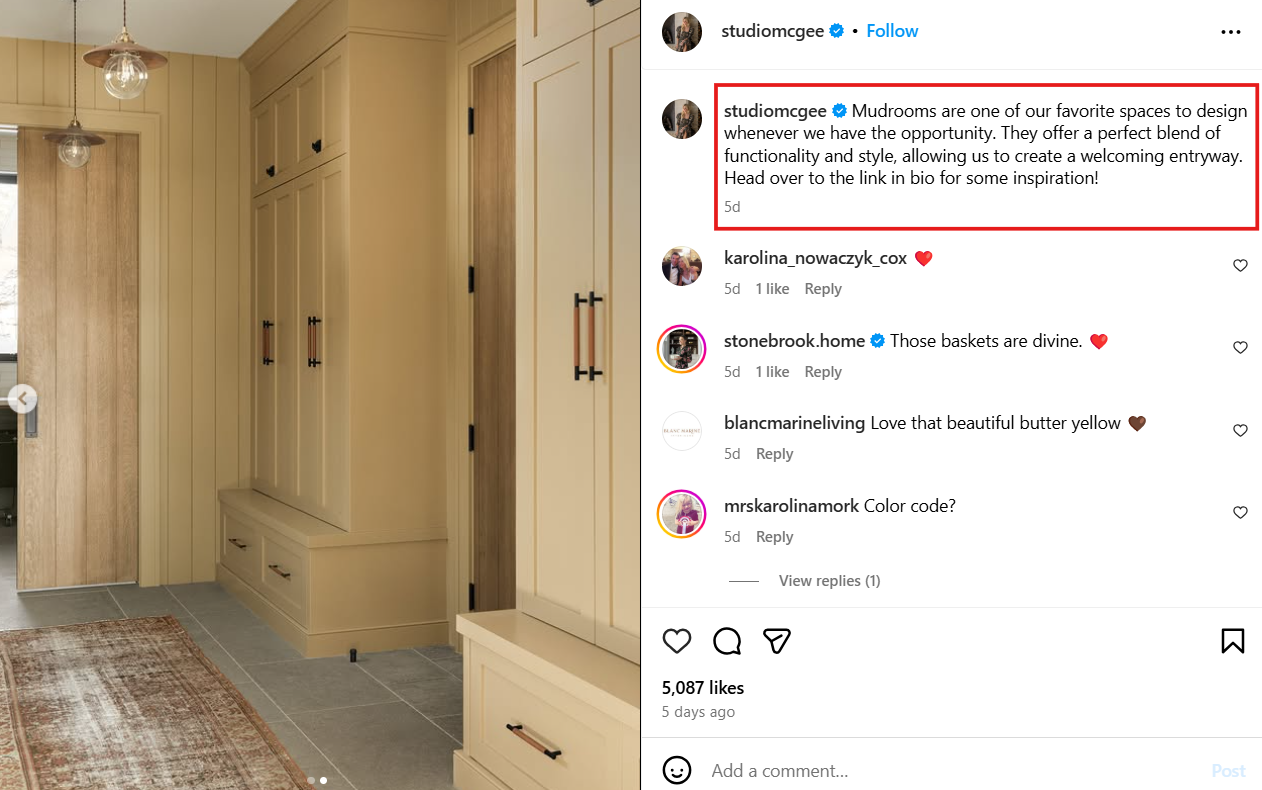
@studiomcgree’s Strategic Use of Keywords and CTA on Instagram -
Stay Consistent Without Burning Out
Posting every day isn’t realistic for most interior designers—and it doesn’t have to be. What matters more is consistency and planning.
Use content batching and scheduling tools like Social Champ to get ahead, and repurpose content across platforms to stretch your efforts further.
A single project reveal can be a full carousel on Instagram, a behind-the-scenes reel, a Pinterest pin, and a LinkedIn case study.
When you show up regularly with value, personality, and authenticity, you stop being “just another designer” and start becoming a brand people remember—and trust.

Your Dream Clients Are Searching. Are They Finding You?
Social Champ makes it easy to be seen on social media. Automate your posts, track performance, and engage with your audience. Start your free trial now!
Utilizing Content Marketing to Establish Authority and Trust
In a space where visuals dominate, content marketing might not seem like a top priority—but it’s one of the most underrated ways to turn casual followers into serious clients.
-
Become the Go-To Resource
When you help people understand design (without overwhelming them), you earn credibility.
Maybe it’s a blog post about how to budget for a home remodel, a video walking through a room refresh, or a newsletter with seasonal styling tips.
When someone learns something from you, you’re already on top of their mind.
You don’t need to give away your whole process, just enough to prove you’re thoughtful, skilled, and worth paying for.
The more you position yourself as an expert, the less you have to sell your services—because your content already did the heavy lifting.
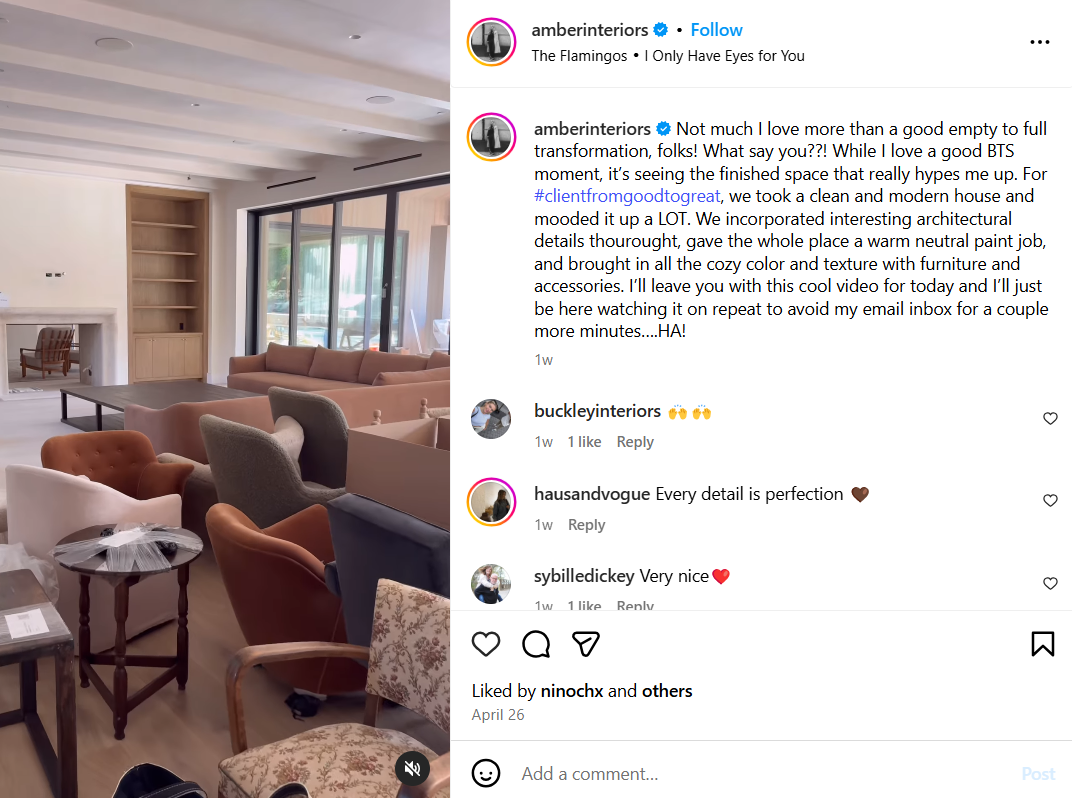
Instagram Post With a Detailed Caption by @amberinteriors -
Focus on Quality Over Quantity
You don’t need to churn out weekly blog posts or film YouTube videos every other day. One thoughtful, well-optimized piece of content can work for you for months.
A great blog can boost your SEO and bring traffic to your site long after it’s published.
A single well-shot video can be clipped into Instagram reels, repinned on Pinterest, and emailed to your list as evergreen content.
Choose content formats that work for your workflow.
-
Use Client Questions as Content Fuel
When you use content to educate instead of pitch, people start seeing you as a trusted advisor, not just a service provider.
And that’s where word-of-mouth grows, inquiries increase, and selling becomes almost effortless.
Start with the questions you’re already getting. If multiple clients ask how long a typical project takes, write a post explaining your timeline.
If people DM you asking about paint finishes, create a mini video series.
Featured Article: Social Media Marketing for Fashion Brands
Implementing SEO Strategies to Increase Online Visibility
If your website isn’t showing up when someone Googles “interior designer near me” or “modern kitchen renovation ideas,” you need to work on your SEO.
SEO (Search Engine Optimization) is the most valuable tool to help clients find you while they’re actively looking.
Here’s how you can work on SEO to improve visibility:
-
Start With Local SEO
If you’re a service-based designer, local SEO is your best friend.
- Claim and optimize your Google Business Profile — Add photos, service descriptions, and your location.
- Include your city/region in your website content — Pages like “Interior Designer in Austin, TX” help Google match you to local searches.
- Encourage client reviews on Google — Reviews not only build trust but also improve your local rankings.
- Add schema markup — It’s nerdy, but structured data helps search engines understand your business better.
-
Use Keywords That Match How People Search
People don’t search for “aesthetic spatial composition.” They search for “small living room layout ideas” or “budget-friendly home office design.
- Use tools like Ubersuggest, Google Keyword Planner, or AnswerThePublic to find real keywords your potential clients are typing.
- Target long-tail keywords — Instead of just “interior designer,” go for “interior designer for small apartments” or “Scandinavian kitchen makeover.”
- Naturally include these keywords in your page titles, image alt text, meta descriptions, and blog posts.
-
Optimize Your Portfolio and Blog
Your design work is your calling card—make sure it’s discoverable.
- Give each portfolio project its own page or post, with a descriptive title like “Modern Farmhouse Living Room Remodel – Brooklyn, NY.”
- Include keyword-rich captions and image alt text. Don’t just write “Project 1”; describe the space, style, and location.
- Blog strategically — Answer questions your ideal clients are Googling. Think “How to choose the right sofa size” or “Best paint colors for north-facing rooms.”
-
Keep Your Site Fast and Mobile-Friendly
No one waits for slow websites to load—and Google knows it.
- Compress your images without sacrificing quality (especially important for image-heavy design sites).
- Use a mobile-responsive website design so it looks great on phones and tablets.
- Avoid clutter and endless pop-ups—clean, professional design matters just as much for your website as it does for your interiors.
Streamlining Marketing Efforts With Social Champ
Let’s face it—marketing can feel like a full-time job, but with Social Champ, interior designers can get plenty of time off of their schedules!
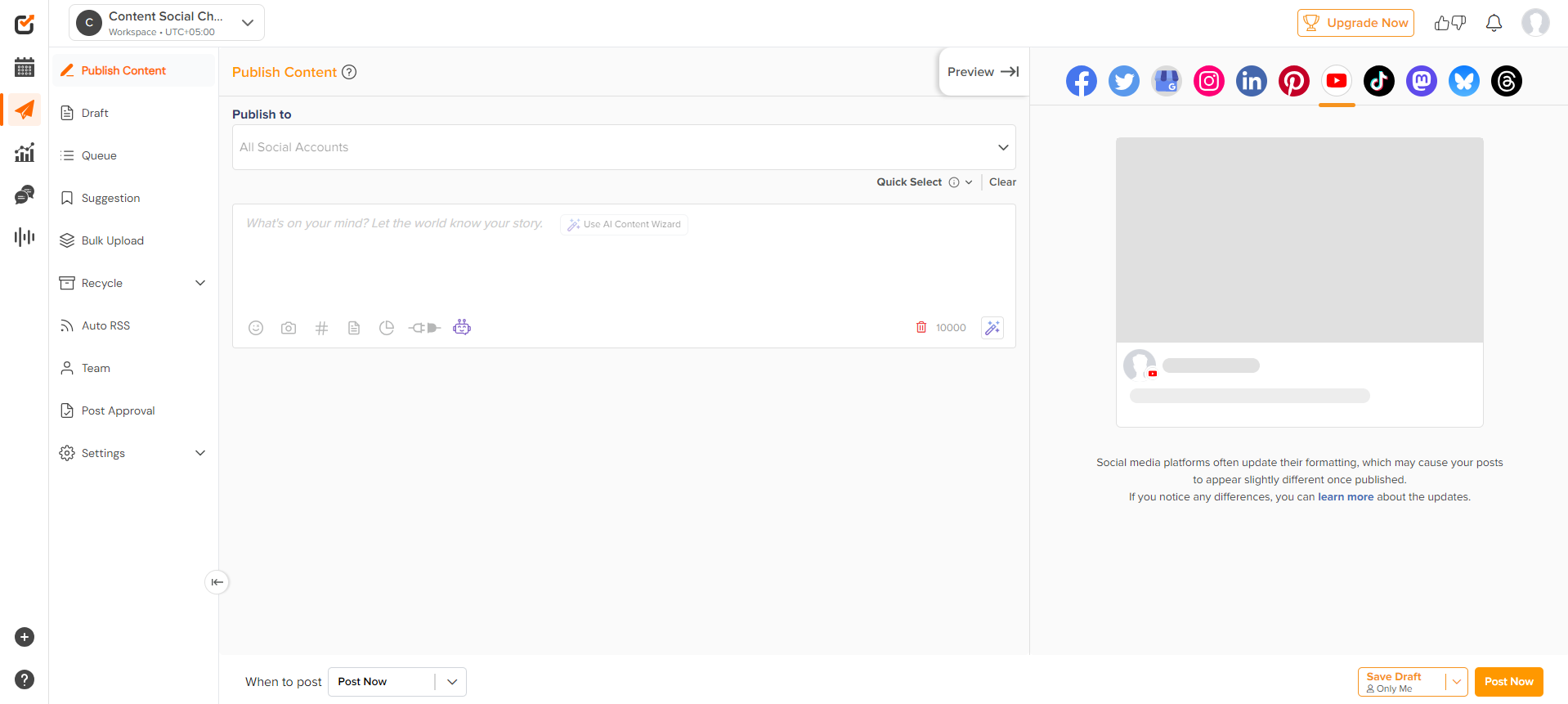
Why Social Champ Works for Interior Designers
Interior design is visual, storytelling-driven, and platform-heavy. You’re not just posting one photo—you’re showcasing a transformation, a vibe, a brand.
Social Champ helps you do that consistently without the stress.
It allows you to plan, schedule, and analyze all your social media posts from one dashboard. No more bouncing between apps. You can just drag, drop, and schedule.
You don’t have to post in real time. You can batch a week (or a month) of content in one go—so when you’re knee-deep in tile samples or staging a shoot, your socials are still working in the background.
Features Interior Designers Actually Need
- Post to 11 Platforms: Publish content across Instagram, LinkedIn, Google Business Profile, Pinterest, Facebook, Mastodon, X (formerly Twitter), Bluesky, YouTube, Threads, and TikTok—all from one place.
- Visual Calendar: See your entire content strategy at a glance. Rearranging posts is as easy as moving tiles around a mood board.
- Platform-Specific Previews: What looks great on Pinterest might need tweaks for Instagram—Social Champ lets you tailor each post per platform without rewriting everything from scratch.
- Bulk Upload & Scheduling: Got a new project to reveal with 20 images? Schedule them all at once across different platforms and forget about it.
- Analytics That Make Sense: It tells you which posts are getting saved, clicked, or shared the most. That means you can stop guessing what your audience loves—and start doubling down on what works.
- Hashtag Management: Save your go-to hashtags for different project types (like #bohobedroom or #coastalkitchen) and plug them in without rewriting every time.
Less Chaos, More Creativity
When you’re not stressing about when or what to post, you get your time and headspace back. And that means more energy for designing spaces your clients love.
Social Champ enables you to take control of your marketing without losing your creative flow.
For interior designers trying to stay consistent online without losing hours to content creation, Social Champ hits the sweet spot: powerful, intuitive, and designed to support the way you work.

Stop Letting Stunning Designs Get Lost in the Scroll!
Get your portfolio on customers’ feed with Social Champ. Stay consistent, showcase your vision, and book clients before your competitors even post.
Conclusion
When you combine strong storytelling with smart tools and strategies, you stop chasing clients and start attracting the right ones.
And that’s what good marketing is all about!
From refining your brand identity to using platforms like Social Champ to stay consistent without the burnout, everything you’ve read here is about working smarter—not harder.
Because your time belongs in the creative flow, not in the weeds of marketing frenzy.
So whether you’re just getting started or ready to scale, remember: great design deserves to be seen. And with the right marketing strategy in place, it absolutely will be.












